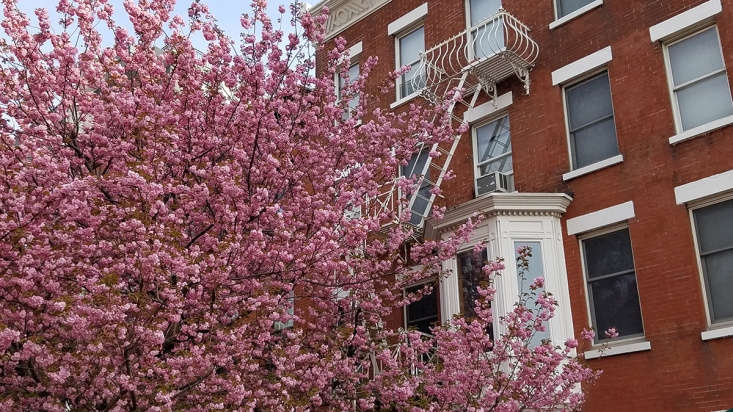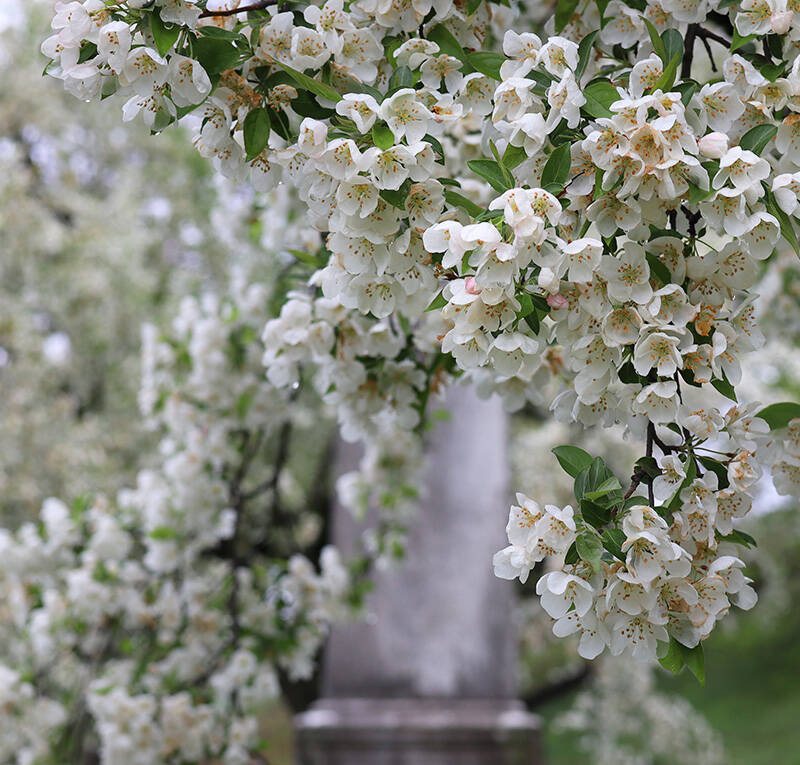Cherry Tree, Prunus: “Symbol of Spring”
Of all the spring-flowering trees, cherries are among the most evocative, and symbolic of a new season. Cherry blossom is the national flower of Japan, and that country’s hanami is the blossom-viewing festival whose tradition has spread to all places where cherries are planted en masse. Flowering cherries’ wide variety of sizes and forms suits them beautifully to home gardens, allowing you to celebrate local bloom in your own yard.
Read on to learn more about what cherries to grow for blooming pleasure.
Photography by Marie Viljoen, unless otherwise noted.

Most flowering cherries are Prunus hybrids and cultivars originating in Japan. One of the best ways to familiarize yourself with different cherry habits and bloom times is to visit a local botanic garden or arboretum in early and mid-spring. There is no lovelier place to spread a blanket, lie on your back and gaze up at the layers of petal glory.
Until bud-break, though, read on for our top cherry choices and how to keep them flourishing.
Higan: Prunus × subhirtella ‘Autumnalis’

Unlike many other flowering cherries, Higan has good disease resistance. Their flowers can be single or double, and vary from the palest of pinks to rose.

Prunus ‘Okame’

Prunus ‘Kanzan’

Like all ornamental cherries, ‘Kanzan’ benefits from occasional interior pruning to allow for good air circulation and sunlight penetration (which helps prevent disease); hardy from zones 5 to 9.
Yoshino: Prunus × yedoensis

Larger than many flowering cherries, Yoshinos top out at about 45 feet. The small, bitter fruit make this cherry a good choice for bird-friendly gardens (and patient jelly makers). It is hardy from zones 5 to 8.
Nanking cherry: Prunus tomentosa

Here is a floriferous cherry whose cold hardiness and abundant, tart, grape-size fruit make it ideal for very hard winters as well as hungry gardeners. Bushy Nanking cherries create spectacular hedges and are as useful in a kitchen garden as they are for ornament. Plant two or more for best fruit-set. Hardy from zones 3 to 7.
Black Cherry: Prunus serotina

In late summer its fruit ripens to a glossy black, tasting like a cross between ripe plums and bitter grapefruit. This indigenous tree is less prone to the pests that bother flowering cherries. Black cherry is hardy from zones 3 to 9.

Cheat Sheet
- Flowering cherries are relatively fast-growing, making them good choices for short- and medium-term gratification.
- The life expectancy of exotic cherries is around 25 to 50 years.
- Manage your cherry expectations: Like other members of the rose family, the trees are susceptible to pests and diseases and must be monitored carefully for general health.

Keep It Alive
- Most cherries are adaptable when it comes to soil type and pH.
- They appreciate plenty of moisture, but do require impeccable drainage—soggy soil will lead to serious problems.
- Full sun (meaning six-plus hours of direct sunlight) is best for optimum cherry health and bloom.
- Test your soil before adding any fertilizer: The test will tell you what is missing or already present.
- Feed your tree annually in early spring, before bud break.
- Do give it a top dressing of compost, but do not mound it around the trunk or it will rot.
- Fungal diseases such as brown rot kill branch tips and affect overall health. Always prune off any diseased or affected twigs and branches.
- In the worst cases, a fungicide should be applied.
See more tips for planting and care at Cherry Trees: A Field Guide and of our favorite flowering trees in our curated design guide to Trees 101, including Apple Trees 101, Dogwood Trees 101, and Lemon Trees 101. For more inspiration, see:
- Cherry Blossoms: 6 Flowering Trees to Grow at Home
- 8 Cold-Climate Flowering Shrubs and Small Trees for Early Spring
- Flowering Magnolias: 7 Favorite Trees to Plant












Have a Question or Comment About This Post?
Join the conversation (2)